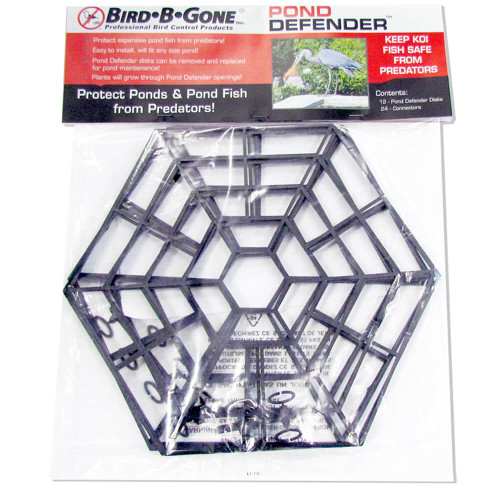Visual Bird Deterrents
Make Birds Flee Areas

Deterring birds with visual bird deterrents are a quick and easy way to start any bird control program. The principle is simple: visual bird deterrents work to frighten birds away from treated areas by using common optical scare triggers such as predator features, motion, or reflective surfaces; when the birds see the bird deterrent, they flee the area. Small birds are especially skittish about what they see. Visual deterrents capitalize on the exceptional vision of birds to create fear sufficient enough to drive them away from food, water, and shelter. When visual deterrents are used correctly and diligently, they make pest birds such as pigeons, crows, starlings, and woodpeckers so uncomfortable that they will quickly fly away and never come back.
How do Visual Bird Deterrents work?
Birds have remarkable vision, which is why Visual Bird Deterrents are so effective. Good eyesight is essential for safe flights as well as safe landings and birds have a number of biological adaptations that result in visual acuity far above other vertebrates. Consider the following notable avian visual variations:
- Birds of prey’s eyes are packed with receptors for maximum visual acuity and their eyes are placed to give them the ability to accurately judge distances.
- Terns, gulls, and other seabirds have yellow and red oil drops in their receptors that enable them to see long distances even in foggy conditions typical of life near the ocean.
- Nocturnal birds such as owls have tubular eyes, low counts of color detectors, and high rod cell counts, allowing their eyes to function optimally in low light.
These and other adaptations give birds of all species exceptional vision and this exceptional vision is what makes visual bird deterrents so effective.
Where Do Visual Bird Deterrents Work Best?
Visual bird deterrents are ideal to use outdoor in areas such as gardens and patios, around fruit trees and pools, and in any other outdoor spaces where birds like to hang out. Visual bird deterrents are an economical, low-cost solution for many common outdoor pest bird problems. They are easy to install, simple to maintain, and, best of all, do no harm to the birds themselves.
Different Types of Visual Deterrents
Bird B Gone offers a variety of visual deterrents that are time tested and proven to keep birds away. Visual deterrents fall into three general classes:
1) Decoys
Red-tail hawks and coyotes are bird predators. Our life-like decoys are a clear message to birds that your property is not safe.
2) Mock Predator Eyes
The distinctive predator eye—a black pupil, a yellow iris, and a bright red surround imitate the look of a large predator. This predator eye comes on a variety of deterrents including reflective scare diverters, balloons, and more.
3) Holographic Flash Tape
Holographic flash tape scares birds away with light, color, and motion. Bird B Gone has spools of flash tape that you can trim and hang easily anywhere. Our SpectrumV Holographic Bird Gel discs also contain holographic elements that reflects and creates visual hot spots that birds will try to avoid.
Tips & Tricks to Help Scare Birds Away
Visual bird deterrents are only successful if they are able to create fear and the fear needs to be substantial enough for birds to leave behind protection, food, and water. Successfully scaring away birds using visual deterrents requires a generous dose of strategic thinking; visual deterrents alone are rarely effective and are never a good substitute for careful planning. The following tips are useful when planning a bird control program utilizing visual deterrents:
Think Like a Bird
What features on your property might attract birds? Remove food and water sources, where possible, and consider exclusion products to prevent birds from accessing attractive nesting sites.
Clean The Area Up
Eliminate any evidence of prior bird infestation. Birds are attracted to their own messes, so remove them.
Start Early
Visual deterrents are the most effective when used at the beginning of a bird problem. Established birds will resist fear and cling to their favorite food, water, and shelter sites.
Consider the Birds You are Trying to Scare
Small, transitory birds are more easily scared than larger ones living in a long-established territory. You’ll need to work harder to frighten birds with more bravado.
Combine Techniques
Larger birds and high-pressure areas that are attractive to birds require a strategic combination of visual deterrents, exclusion products, and repellents to keep birds away.
Switch Things Up
In reality, for persistent bird problems, no single visual deterrent is effective long-term. Birds are smart and adapt to seeing the same deterrent in the same location day after day. Use a range of deterrents. Switch them out and move them regularly to keep birds at bay.
Visual Bird Deterrents from Bird B Gone
Visual deterrents are a non-lethal, effective method for discouraging the presence of birds. Once you give the birds the impression that your property is not safe, they will think twice about moving in. Shop Bird B Gone’s full range of visual deterrents to find a solution that’s just right for you. We’ve got the products and the experience you need to get the job done right.
If you need help choosing the right visual deterrent, call us; we are here to help. 800-392-6915












